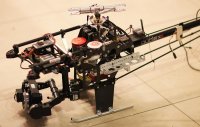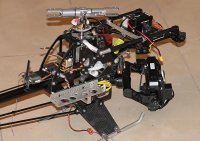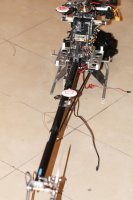Thanks Rob but actually I only have access to a CNC lathe so I use my old tool making skills to make those pre production parts. I reckon I can file it to within .001" .
As far as any electronics are concerned I tend to use no more than is needed. Here is a good enough reason for that thinking.
As soon as I read about the first FOD with the S800 I set up a test rig to strap it down to a workmate portable bench. I very soon found that I was able to induce the FOD with constant mode changes in and out of GPS and Atti modes. So I new where the problem was a very long time before DJI found it. So the reason that I totally avoided any problems when all around me were crashing was because I (and my students that bought S800's as a package of equipment and training) used a different flight program. We started up in GPS and then switched to atti. before take-off. No other autonomous modes were ever used. 250+ trouble free flights including a few commercial assignments. The S800 when it was dialed-in was nice to fly and a very capable package. Will it do what this TDR can do? Never. Sorry about that! You can argue about it til the cows come home but the laws of Physics always win.
When Skookum announced they were getting into GPS I lost interest until I can see 2 months of trouble free use. All this delayed release has me worried. I think DJI have learned a valuable lesson and they said that the whole GPS algorithm has been rewritten. I will try Naza H without GPS and when I can do the same tests I may use the GPS but there is no substitute for having the right man on the sticks. The GPS you see in that picture is for the Gimbal system. Mini V-Bar stabi is the stabilizer of choice for just about everyone who puts 3 D helis through the hardest test of all. I'm sure DJI want a share of that market as well but it's gonna be one strike and your out. so I guess they will be on their toes this time around.
As far as any electronics are concerned I tend to use no more than is needed. Here is a good enough reason for that thinking.
As soon as I read about the first FOD with the S800 I set up a test rig to strap it down to a workmate portable bench. I very soon found that I was able to induce the FOD with constant mode changes in and out of GPS and Atti modes. So I new where the problem was a very long time before DJI found it. So the reason that I totally avoided any problems when all around me were crashing was because I (and my students that bought S800's as a package of equipment and training) used a different flight program. We started up in GPS and then switched to atti. before take-off. No other autonomous modes were ever used. 250+ trouble free flights including a few commercial assignments. The S800 when it was dialed-in was nice to fly and a very capable package. Will it do what this TDR can do? Never. Sorry about that! You can argue about it til the cows come home but the laws of Physics always win.
When Skookum announced they were getting into GPS I lost interest until I can see 2 months of trouble free use. All this delayed release has me worried. I think DJI have learned a valuable lesson and they said that the whole GPS algorithm has been rewritten. I will try Naza H without GPS and when I can do the same tests I may use the GPS but there is no substitute for having the right man on the sticks. The GPS you see in that picture is for the Gimbal system. Mini V-Bar stabi is the stabilizer of choice for just about everyone who puts 3 D helis through the hardest test of all. I'm sure DJI want a share of that market as well but it's gonna be one strike and your out. so I guess they will be on their toes this time around.
Last edited by a moderator:



